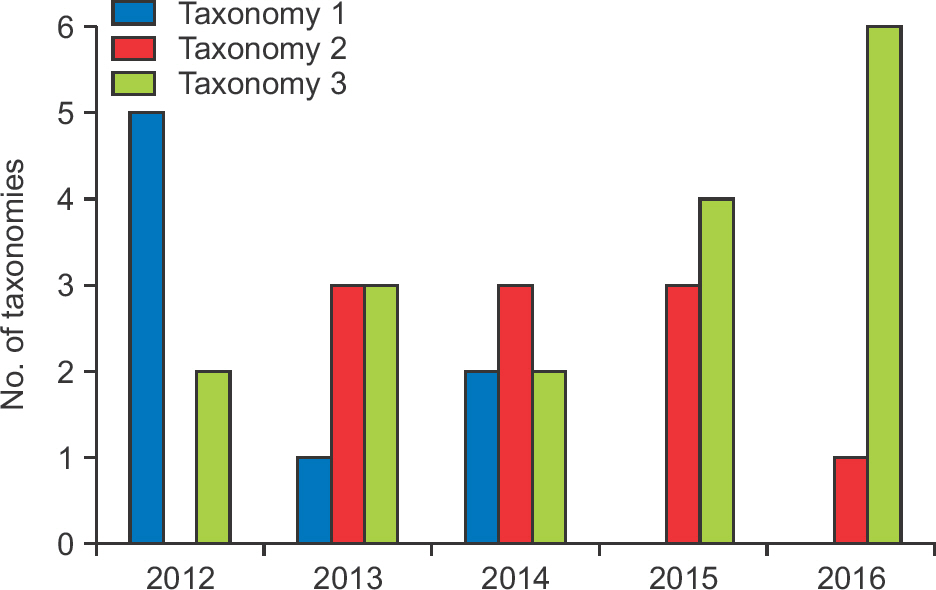J Korean Foot Ankle Soc.
2017 Sep;21(3):104-107. 10.14193/jkfas.2017.21.3.104.
An Analysis of the Foot and Ankle-related Questions on the Korean Orthopedic In-Training Examination
- Affiliations
-
- 1Department of Orthopaedic Surgery, Samsung Changwon Hospital, Sungkyunkwan University School of Medicine, Changwon, Korea. orthoshin@gmail.com
- KMID: 2389940
- DOI: http://doi.org/10.14193/jkfas.2017.21.3.104
Abstract
- PURPOSE
The purpose of this study was to evaluate the questions pertaining to the foot and ankle on the Korean Orthopedic In-Training Examination (KOITE) between 2012 and 2016.
MATERIALS AND METHODS
Questions regarding the foot and ankle on KOITE during the five-year period (2012∼2016) were analyzed. Number of foot and ankle questions, topics, taxonomic classification, imaging modalities, and cited references related to each question were analyzed.
RESULTS
The average number of foot and ankle questions was 35, accounting for 7.0% (35/500) of all KOITE questions. All questions were categorized into three topic areas: disease (51.4%, 18/35), trauma (31.4%, 11/35), and basics (17.1%, 6/35). Taxonomy 3 (decision-making type questions) was the most common (42.9%, 15/35). References that are commonly used for each question were Campbell's Operative Orthopedics (100%, 35/35) and the textbook of The Korean Orthopaedic Association (74.3%, 26/35).
CONCLUSION
This analysis can be valuable to not only orthopaedic surgery residents to improve their knowledge of orthopedics, but also to instructors for optimizing their education programs.
Figure
Reference
-
11.Suk SI., Chang IY., Yoo MC., Chung MS. The first In-Training Examination for Residents in Orthopaedic Surgery1 J Korean Or-thop Assoc1. 1980. 15:874–81.21.Srinivasan RC., Seybold JD., Kadakia AR. Analysis of the foot and ankle section of the Orthopaedic In-Training Examination (OITE)1 Foot Ankle Int1. 2009. 30:1060–41.31.Osbahr DC., Cross MB., Bedi A., Nguyen JT., Allen AA., Altchek DW, et al. Orthopaedic In-Training Examination: an analysis of the sports medicine section1 Am J Sports Med1. 2011. 39:532–71.41.Kim DH., Kim JY., Shim SB., Kim JH. Analysis of Korean Orthopedic In-Training Examination: the hand and wrist section1 J Korean Soc Surg Hand1. 2016. 21:1–71.51.Buckwalter JA., Schumacher R., Albright JP., Cooper RR. Use of an educational taxonomy for evaluation of cognitive performance1 J Med Educ1. 1981. 56:115–211.61.Walsh CT., Grandizio LC., Klena JC., Parenti JM., Cush GJ. Levels of evidence for foot and ankle questions on the Orthopaedic In-Training Examination: 15-year trends1 J Surg Educ1. 2016. 73:999–10031.71.Barr CR., Cheng I., Chou LB., Hunt KJ. Foot and ankle questions on the Orthopaedic In-Training Examination: analysis of content, reference, and performance1 Orthopedics1. 2012. 35:e880–81.81.Cho Y., Kim JY., Park JH. Analysis of the Korean Orthopedic In-Training Examination: the hip and pelvis section1 Hip Pelvis1. 2016. 28:157–631.
- Full Text Links
- Actions
-
Cited
- CITED
-
- Close
- Share
- Similar articles
-
- Current Trends in the Treatment of Diabetic Foot: Analysis of the Korean Foot and Ankle Society (KFAS) Member Survey
- Current Trends in the Treatment of Ankle Arthritis: Analysis of the Korean Foot and Ankle Society (KFAS) Member Survey
- Analysis of Korean Orthopedic In-Training Examination: The Hand and Wrist Section
- How Effective Is the Injection Therapy in Foot and Ankle Disorder?
- Rehabilitation of Common Ankle and Foot Sports Injuries



